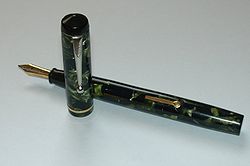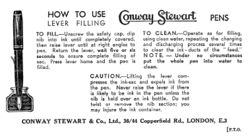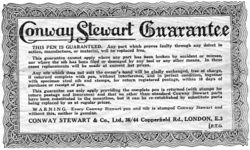Conway Stewart
The birth of Conway Stewart is traced back to 1905. The company entered the British market that already saw the presence of several local producers, and owes its success to a clear market choice: to produce reliable products at a small price, which would reach a more wide public. Although the company has never distinguished itself for technological innovations, its pens were good, reliable and reasonably priced, so they had a great success, and their most preminent characteristic was the enormous variety of colors in which they were produced.
But the traditional lack of attention for technical innovations and market positioning on the economic production was also the cause of the decline of the company, which was not able to adapt to the advent of the ballpoint pen. With the diffusion of economic disposable ballpoint pens, Conway Stewart fountain pens become too expensive to be used as cheap writing tools, but beeing positioned on the economic side of the market they cannot be also used ad objects of distinction. So the company suffered an inexorable decline and in 1975 was closed. As happened with many other historical brands, Conway Stewart was resurrected in 1998 to exploit the prestige of their trademark in the production of modern pens.
| Conway Stewart |
|---|
| Brand pages |
| Brand advertising |
| Brand photos |
| Instructions sheet |
| Patents |
History
Conway Stewart was founded in 1905 in London by Frank Jarvis and Thomas Howard Garner with headquarters staff at 13 Paternoster Row. The origins of the name are not so clear, the most common version tells that it was inspired by the names of two actors that recited at the Collins Music Hall in Islington, and adopted for commercial reasons (it seems it sounds better than Jarvis Garner).
The company started its business marketing, in 1906, american pens named Self Filling and Self Cleaning Post; the same year Stanley Jarvis, brother of Frank, joined the company. In 1909 the company was incorporated as Conway Stewart & Co. Ltd. The initial production, on which there is very little information, was made by eyedropper hard rubber pens, produced in the plant site of Upper Thames Street, in London.
Despite the presence on the market of already well established companies like Onoto and Swan, and in the absence of specific skills in the technological innovation field, Jarvis and Garner proved to have good business skills, and identified for the best the market positioning of their company. They concentrated into the mass production of a reliable product sold at a lower cost than competitors, in order to meet the growing demand and enlarge the market, a position that will not change in the history of Conway Stewart.
In 1919 the first lever filler and safety models were introduced, the following year the brand The Conway Stewart was officially registered (with the number 407502). In 1922 new models were introduced, including the Dinkie,[1] which will become the most famous product of the company (so that the name became a registered trademark in 1924). The Dinkie was a small and functional pen, which was produced in different versions for over 40 years. In 1924 Conway Stewart was the first British company to sell celluloid pens,[2] The use of celluloid, for the variety and richness of the colors they used, is one of the distinguishing features of this brand.
The classification of Conway Stewart models is extremely complex, although since the '20s the company started using names, all the pens were still identified by a number and sometimes only by that. In the '20s the top model (which will remain so for two decades) was the Duro, a large pen, then there was the small and functional Dinkie, and the economic Universal. Other models made in the same period were the Pixie and the Dandie.
After the first years almost the entire production of Conway Stewart were lever filler pens, but in 1927 the company also produced some button filler models that sells at the same price of the lever filler ones, which remained the most diffused. Until the late '20s pens had the conventional flattop shape with cylindrical body and flat ends, while the cap had an hard rubber head. The pens were produced with or without cap rings according to their price level. Initially, the clip was fixed on one side of the cap and had a ball tip.
The company passed the great financial crisis of 1929 without too many problems; profits decreased for the sales decrease, but having concentrated its production on economic pens helped to overcome the worst phase of the crisis, just in 1934 Conway Stewart was again making rising profits. In 1935 the Conway Stewart & Co. Ltd was voluntarily closed to create a new company listed on the London Stock Exchange.
The Conway Stewart production was still characterized by the colors used in their celluloid pens. Apart from the classic black the company began to sell a wide variety of colored pens, well beyond the classic marbled colors typical of other companies. Even though there are no official names, some names have become standard between collectors, like the Tiger eye, the Cross hatch, the Herringbone or the most famous Cracked ice (black with thin white veins), which was introduced in 1934.
In questo periodo le penne della Conway Stewart erano prodotte con uno stile più affusolato, seguendo la tendenza dello streamlined in voga oltreoceano. Nel 1932 il fermaglio venne realizzato con la parte superiore ad anello, molto simile a quello della Duofold, e bloccato sul cappuccio da una testina in ebanite; nel 1935 venne introdotta la clip con la cima a forma di diamante, che da allora contraddistinguerà i modelli dell'azienda in tutti gli anni successivi.
Nel 1940 venne proposto un modello con una sezione trasparente per il controllo del livello dell'inchiostro, ma non ebbe un gran successo a causa della guerra; nello stesso anno vennero anche introdotti dei modelli con caricamento a stantuffo, che andarono ad aggiungersi a quelli con caricamento a levetta e pulsante di fondo. Nonostante i pesanti bombardamenti la fabbrica della Conway Stewart restò miracolosamente quasi illesa ed alla fine della guerra l'azienda riuscì a riprendere subito la produzione.
Nel dopoguerra i nuovi modelli dalla Conway Stewart vennero realizzati con una forma più affusolata ed in una grandissima varietà di colorazioni, una caratteristica questa che diventerà uno dei marchi distintivi dell'azienda. I nuovi modelli avevano una nuova clip, sempre ad anello e con punta a forma di diamante, che però veniva bloccata in posizione da un bottone a scatto di forma simile ai Jewel delle Vacumatic. Vennero anche prodotte penne da esportazione (rivolte principalmente al mercato del Benelux) con il marchio Le Tigre.
Nel dopoguerra i vari modelli vennero identificati esclusivamente tramite codici numerici, con la sola eccezione del marchio Dinkie che continuò ad essere utilizzato. Purtroppo questo non consente affatto di semplificare la classificazione delle penne prodotte dalla Conway Stewart, perché la scelta di questi codici non ha mai seguito nessuna sequenza o ordine di natura logica o cronologica; inoltre spesso venivano usati codici diversi a seconda della destinazione della penna (se cioè era destinata all'esportazione o meno). Nel 1949 venne lanciato come il modello di punta il modello 58, che venne sostituito in questo ruolo l'anno successivo dal modello 60.

A metà degli anni '50 la Conway Stewart era all'apice del suo successo. Nel 1954 l'azienda introdusse il prestigioso modello 100, una penna di grandi dimensioni. In questo periodo iniziarono ad apparire sul mercato le prime penne a sfera, che come negli Stati Uniti erano costose e inaffidabili, ma l'azienda continuò ad ignorare la novità e questo atteggiamento tradizionalista le fu fatale. L'azienda entrò in ritardo anche nell'uso dei nuovi materiali plastici (introdotti soltanto nel 1957) e non seguì mai le nuove tendenze stilistiche delle penne a pennino coperto lanciate dalla Parker 51.
L'azienda continuò a mantenere la sua politica di produrre stilografiche di buona qualità ad un prezzo modico facendo ricorso a metodi tradizionali e ben consolidati, ma se nella prima metà degli anni '50 una penna a levetta con pennino e cappuccio a vite era soltanto un po' fuori moda, ma perfettamente funzionale, nella seconda metà degli anni '50 e negli anni successivi diventò sempre più arretrata ed incapace di trovare un suo spazio sul mercato, di fronte a penne a sfera usa e getta dai prezzi molto più bassi, contro le quali l'azienda non era in grado di competere, e l'impossibilità di caratterizzare le sue stilografiche, pur sempre degli oggetti economici, come un oggetto distintivo o di moda.
Nonostante alcuni tentativi di rilancio, e la produzione di alcune penne a sfera, il passaggio al caricamento a cartuccia e la produzione di alcuni esemplari economici a pennino coperto, il declino proseguì inesorabile per tutti gli anni '60, fino alla definitiva chiusura della società, avvenuta per fallimento, a seguito di un ordine dell'Alta Corte di giustizia datato 21 giugno 1975.
Template:CronoMarche |- | 1905 || Frank Jarvis e Thomas Howard Garner danno vita alla Conway Stewart |- | 1909 || La Conway Stewart viene fondata come società a responsabilità limitata |- | 1919 || Vengono introdotti modelli con caricamento a levetta e safety |- | 1920 || Viene registrato ufficialmente il marchio The Conway Stewart |- | 1920 || Viene introdotto il modello Duro |- | 1922 || Vengono introdotti i modelli Dinkie, Pixie e Universal |- | 1924 || Viene introdotto il modello Dandy |- | 1924 || Depositati i marchi Dinkie e Duropoint |- | 1924 || Vengono introdotti i primi modelli in celluloide colorata (o 1920?) |- | 1927 || Viene brevettato ed immesso sul mercato un caricamento a pulsante di fondo |- | 1933 || Vengono introdotti i modelli Scribe e International |- | 1934 || Viene introdotta la celluloide Cracked Ice |- | 1935 || La Conway Stewart si ristruttura diventando società per azioni |- | 1935 || Introdotto il fermaglio a forma di punta di diamante |- | 1949 || Viene introdotto il modello 58 |- | 1950 || Viene introdotto il modello 60 |- | 1954 || Viene introdotto il modello Conway Stewart 100 |- | 1955 || Viene introdotto il modello 22 Floral |- | 1955 || Viene introdotta la celluloide Herringbone |- | 1957 || Cessa la produzione in celluloide passando alla plastica a stampo |- | 1957 || Viene introdotta la prima penna a sfera |- | 1975 || La Conway Stewart fallisce e viene chiusa |- |}
Template:LegendaModelli |- | Dinkie || 1922 ? || XX, ? |- |}
Note
Riferimenti esterni
- http://www.ftic.info/Donahaye/ConwayStewart/ Sito di un appassionato, una mole di informazioni impressionante
- http://conway-stewart.old-pens.co.uk/index.htm Altro sito di un appassionato, altra mole di informazioni
- http://en.wikipedia.org/wiki/Conway_stewart La Conway Stewart su Wikipedia
- http://www.conwaystewart.com/ Sito ufficiale, qualche informazione storica, ma molto agiografica
- http://www.csvpens.co.uk/page5.html Articolo sulla storia dell'azienda, interessante
- http://www.rickconner.net/penspotters/conway.old.html Articolo di Penspotters
- http://conwaystewartpens.co.uk/ Sito di un rivenditore di Conway Stewart d'epoca, contiene anche qualche informazione storica
- http://www.mvburke.com/history.htm Articolo sulla storia della Conway Stewart


